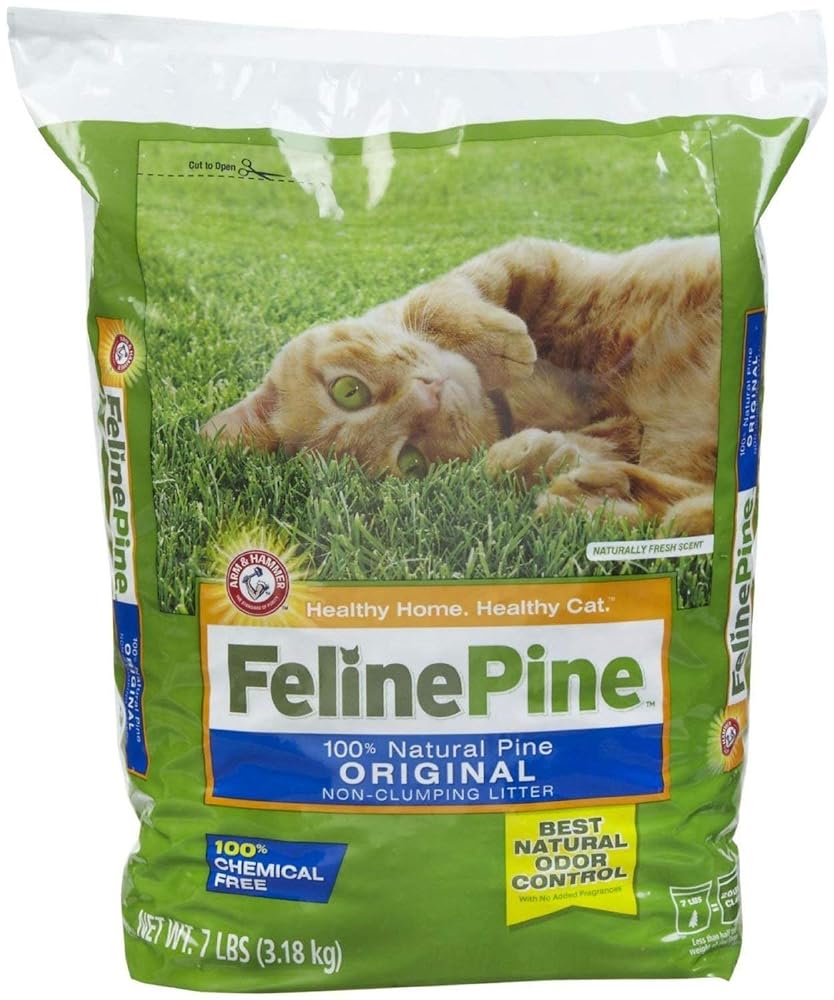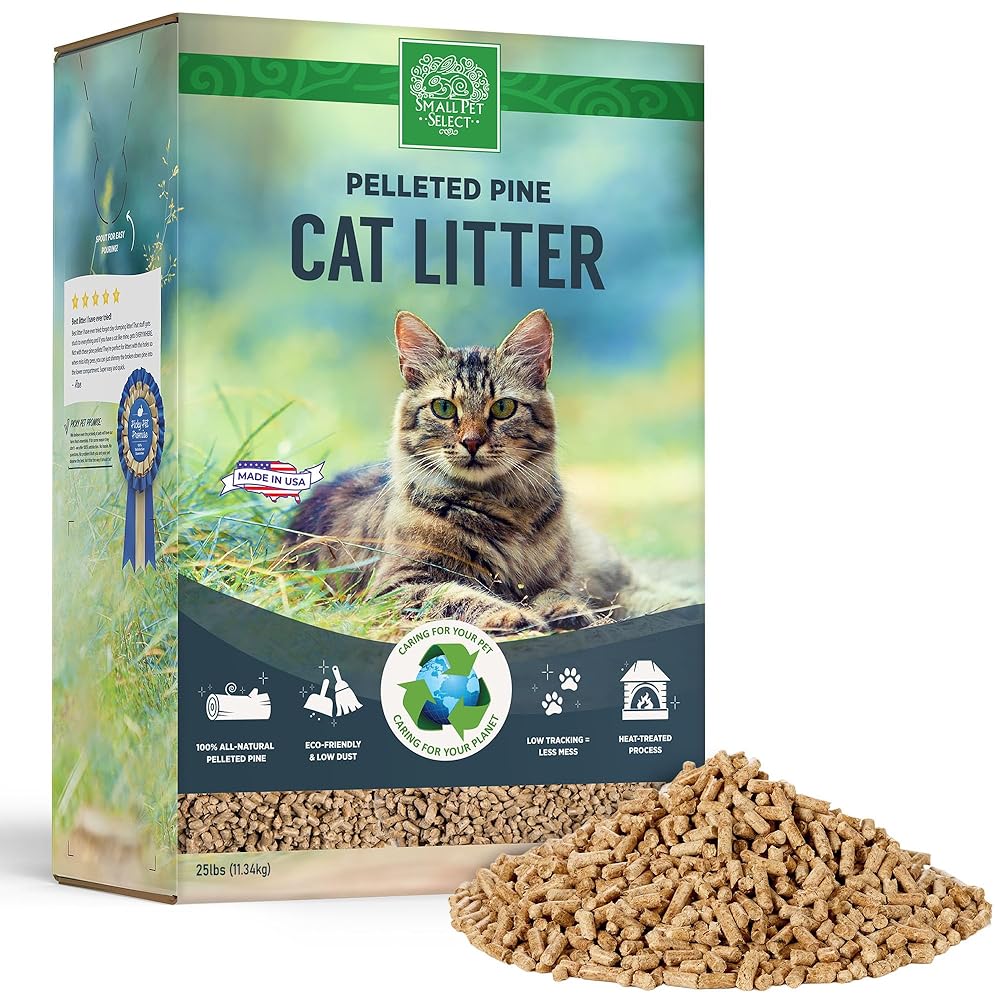iHeartCats is reader-supported. When you buy via links on our site, we may earn an affiliate commission at no extra cost to you.
Welcome to the world of feline hygiene where the choice of cat litter can make a significant difference in your cat’s health and your home’s cleanliness. Among the array of options, pine pellet cat litter stand out as a natural, sustainable, and odor-fighting solution. In this article, we delve into the best pine pellet cat litter on the market, examining their benefits for both your beloved pet and the environment. From their natural pine scent that keeps the litter box smelling fresh to their super absorbent nature that makes maintenance a breeze, pine pellet litters are a choice worth considering for any cat owner looking to combine practicality with eco-consciousness.
#1 – Feline Pine Original Cat Litter, 7-Pound Bags (Pack of 2)
Feline Pine Original Cat Litter is a 7-pound bag of cat litter made from pine material. It is trademarked by FELINE PINE and manufactured by Feline Pine. This cat litter is designed to provide an effective and natural solution for cat owners looking for an alternative to traditional clay litter.
Best For: All cat owners looking for an affordable and natural cat litter option.
#2 – Small Pet Select Premium Pine Pelleted Cat Litter, 100% All Natural Pellet Kitty Litter, Non-Clumping Non-Tracking Low Dust Litter Meant for Use with Sifting Litter Box, Made in USA, 25 lbs
Small Pet Select Premium Pine Pelleted Cat Litter is a 100% all-natural and non-clumping kitty litter made from heat-treated wood pellets. It is designed to be used with a sifting litter box and is ideal for pet owners who want to minimize the potentially harmful effects of regular litter. The litter is made from natural pine and has no additives or chemicals, and it breaks down easily for safe disposal.
#3 – Casual Home 100% Natural Pine Wood Non-Clumping Cat Litter Wood Pellets
The Casual Home 100% Natural Pine Wood Non-Clumping Cat Litter Wood Pellets is an all-natural cat litter made from pine wood without any synthetic additives. It has a low dust and low tracking formula, making it easy to keep the litter in the litter box. The non-clumping formulation allows for quick and painless cleaning of the litter box.
What Are The Pros and Cons of Pine Pellet Cat Litter?
Pine pellet cat litter is a popular choice among cat owners for several reasons, but it’s essential to weigh both its advantages and disadvantages.
Pros:
- Natural Odor Control: Pine naturally neutralizes odors without the need for artificial fragrances. Its woodsy scent keeps the litter box smelling fresh.
- Highly Absorbent: Pine pellets are capable of absorbing a significant amount of moisture, which helps to keep the litter box dry and reduces the growth of bacteria.
- Low Dust: Unlike some clumping litters, pine pellet litters produce minimal dust, which is beneficial for cats and owners who have respiratory issues or allergies.
- Eco-Friendly: Pine pellets are often made from recycled wood waste, making them a more sustainable and biodegradable option compared to clay litter.
- Non-Clumping: This can be a pro for those who prefer easy cleanup since the pellets disintegrate into sawdust when wet and can be sifted out without scooping clumps.
Cons:
- Non-Clumping: For some, the non-clumping nature of pine pellets is a downside since it can make scooping urine more challenging compared to clumping litter.
- Transitioning Issues: Some cats may be hesitant to switch from their regular litter to pine pellets because of the difference in texture and scent.
- Tracking and Mess: While less dusty, the sawdust created from wet pellets can stick to cat paws and be tracked outside the litter box.
- Weight and Disposal: Pine pellets can be heavier than other litters, and while biodegradable, not all disposal methods are eco-friendly (e.g., not all can be composted or flushed).
- Cost: Depending on the brand and location, pine pellet litter can be more expensive than traditional clay litter, which may be a factor for some budgets.
It’s important to consider your cat’s habits and preferences, as well as your own capacity for maintenance and your environmental values when choosing a litter. Some cats may take to pine pellet litter immediately, while others may need a gradual transition. It’s always best to introduce any new litter slowly, mixing it with the old litter and increasing the proportion over time.
Frequently Asked Questions About Pine Pellet Cat Litter
- Is pine pellet cat litter safe for cats? Pine pellet cat litter is generally safe for most cats. It is made from natural pine wood, which is non-toxic, and the pellets are too large to pose a significant ingestion risk. However, if your cat has a history of eating non-food items, it’s best to monitor their initial interactions with the litter.
- Can pine pellet litter be flushed down the toilet? It’s not recommended to flush pine pellet litter down the toilet. Although pine is biodegradable, it can absorb water and expand, potentially causing blockages in your plumbing system. Always check with the manufacturer’s guidelines and your local sewage regulations.
- Will pine pellet litter control odors as well as clay litter? Pine pellet litter is known for its natural odor-control abilities. The pine wood has a natural scent that neutralizes odors, and its high absorbency helps contain the smell of urine. However, it may not mask odors as heavily as some clay litters that are perfumed.
- How often should I change pine pellet cat litter? The frequency of changing pine pellet litter depends on the number of cats using it, but generally, the pellets should be sifted daily, and the sawdust should be removed. The entire litter box should be changed every two weeks or when you notice an overall decrease in odor control.
- Is pine pellet litter environmentally friendly? Pine pellet litter is more environmentally friendly than many other types of litter. It’s usually made from recycled wood waste, is biodegradable, and produces minimal dust, which is better for the environment than clay-based litter that does not decompose easily.
- Can kittens use pine pellet litter? Kittens can use pine pellet litter but with supervision. Since kittens are more likely to ingest litter out of curiosity, it’s essential to ensure they’re not eating the pellets. Additionally, its larger size might be less comfortable for tiny paws, so a gradual introduction is recommended.
- How do I transition my cat to pine pellet litter? To transition your cat to pine pellet litter, start by mixing the pine pellets with your current litter, gradually increasing the amount of pine over time. This slow change helps your cat acclimate to the texture and scent of the new litter without stress.
- Can pine pellet litter be used with automatic litter boxes? Most automatic litter boxes are designed for clumping litter and may not be compatible with pine pellets. The pellets don’t clump and can cause mechanical issues. Always check with the manufacturer of your automatic litter box before making the switch.
- What should I do if my cat doesn’t like pine pellet litter? If your cat is resistant to using pine pellet litter, don’t force the switch. You can try a slower transition, mixing the pine pellets with their old litter in increasing amounts, or you may need to consider a different type of litter that is more to your cat’s preference.
- Are pine pellets more cost-effective than other litters? Pine pellets can be cost-effective as they are often less expensive over time than clumping clay litters. They tend to last longer because you typically remove only the soiled sawdust, not large clumps of urine, making a bag of pine pellets extend further.
Conclusion: Best Pine Pellet Cat Litters
Navigating the world of cat litter can be a complex endeavor, but as we’ve explored, pine pellet cat litter offers a compelling combination of odor control, moisture absorption, and environmental friendliness. By choosing the right pine pellet litter, you’re not only providing a healthy and appealing bathroom experience for your feline friend but also contributing to a greener planet. Remember to consider your cat’s preferences and any specific health concerns as you make your selection. With the insights from this article, you are well-equipped to make an informed decision that ensures your cat’s well-being and supports a sustainable lifestyle.




